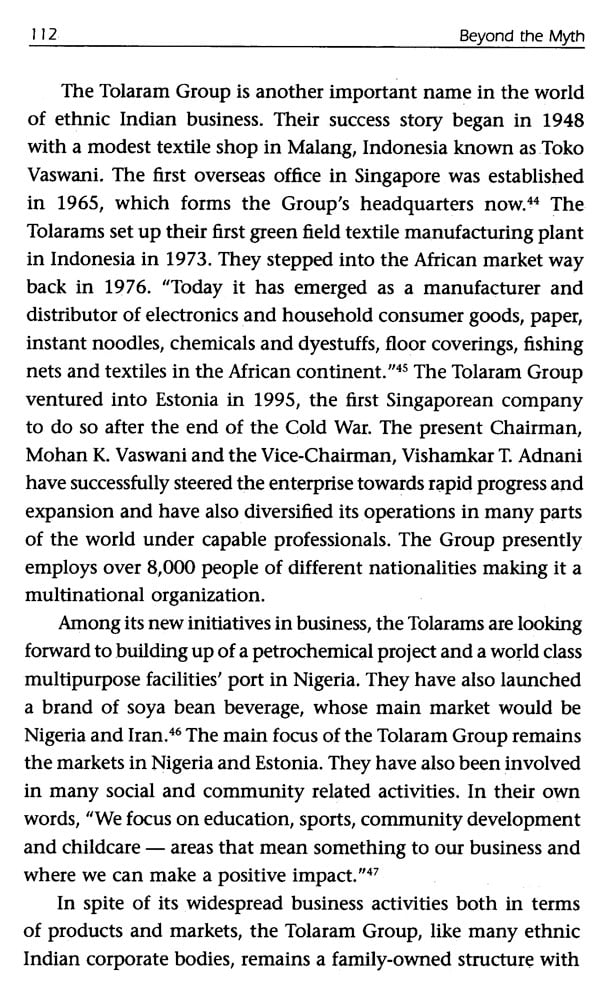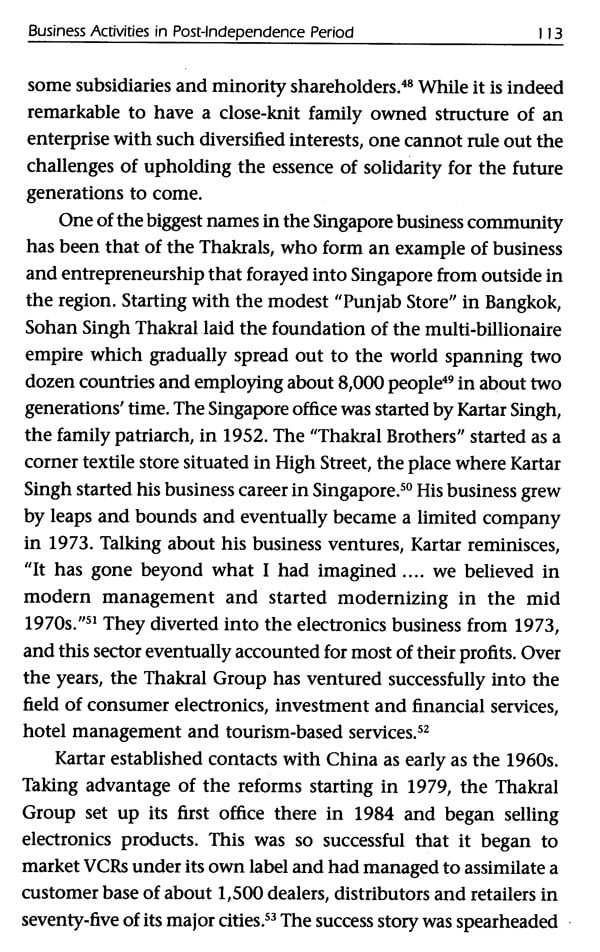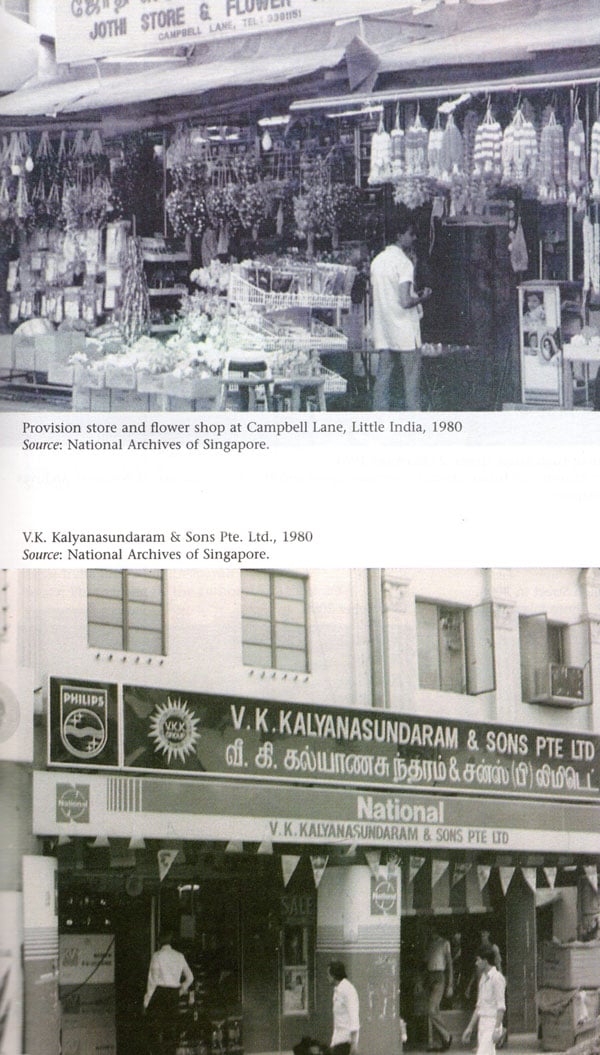
Beyond The Myth (Indian Business Communities In Singapore)
Book Specification
| Item Code: | NAZ848 |
| Author: | Jayati Bhattacharya |
| Publisher: | Manohar Publishers and Distributors |
| Language: | English |
| Edition: | 2012 |
| ISBN: | 9788173049545 |
| Pages: | 372 (17 Color Illustrations) |
| Cover: | HARDCOVER |
| Other Details | 8.80 X 5.80 inch |
| Weight | 700 gm |
Book Description
This book is a macro-study of Indian business communities in Singapore through different phases of their growth since colonial times. It goes beyond the conventional labour-history approach to study Indian immigrants to Southeast Asia, both in terms of themselves and their connections with the people's movements. It looks at how Indian business communities negotiated with others in the environments in which they found themselves and adapted to them in novel ways. It especially brings into focus the patterns and integration of the Indian networks in the large-scale transnational flows of capital, one of the least studied aspects of the diaspora history in this part of the world. The complexities and overlapping interests of different groups of traders and businessmen form an interesting study of various aspects of these trading bodies, their methods of operation and their trade links, both within and outside Singapore. The book also charts their mobility and progress, in terms of both business and social status. The research aims to construct linear threads of linkages through generations and situate them in the, larger framework and broader paradigms of business networks in Singapore.
In shedding light on aspects of Indian connectivities to Southeast Asia, the narrative is particularly relevant in the context of India's economic rise. This study raises economic, social and cultural issues regarding the transition.
Jayati Bhattacharya is a Visiting Research Fellow at the Nalanda-Sriwijaya Centre, Institute of Southeast Asian Studies (ISEAS) in Singapore with research interests in business history and diaspora studies in South and Southeast Asia in the modern period. She is currently the coordinator of the project on Comparative Diasporas at the Centre. Dr Bhattacharya has received her Ph.D. from the Jawaharlal Nehru University, New Delhi. She was awarded a Junior Research Fellowship by the Jawaharlal Nehru Memorial Fund, New Delhi and a scholarship by the Indian Council of Historical Research (ICHR), New Delhi to pursue doctoral studies. Dr Bhattacharya has teaching experience as Lecturer in Loreto College, Darjeeling, India and as a Guest Lecturer at Qingdao University, People's Republic of China. She has also contributed articles on business history in the colonial period of Bengal. Her forthcoming publications include Jayati Bhattacharya and Coonoor Kripalani Thadani, eds., Indian and Chinese Immigrant Communities: Comparative Perspectives (tentative title), (forthcoming); Oliver Pye and Jayati Bhattacharya, eds., The Palm Oil Controversy in Transnational Perspective (forthcoming).
Since the pioneering work of Kernail Singh Sandhu and S. Arasaratnam, studies of Indian communities in Singapore (and Malaya/Malaysia) have grown significantly in scope and content. Even before "Diaspora Studies" became topical, a spate of scholarly and popular accounts, detailing the rich diversity and spread of overseas Indians in Southeast Asia, published in the 1970s and 1980s, has enriched our understanding of the movement to, settlement in, and socialization of Indian communities in their adopted homelands outside the Indian subcontinent. The monumental trailblazer, Indian Communities in Southeast Asia, edited by K.S. Sandhu and A. Mani (first published by the Institute of Southeast Asian Studies in 1993, and reprinted in 2006) marked a significant scholarly milestone in the development of the field by bringing together, in one volume, in-depth analyses of Indian communities settled in various parts of the region. This was followed in 2006 by the publication of the Encyclopedia of Indian Diaspora, produced by a group of scholars from the National University of Singapore, which is, to date, still probably the most comprehensive and authoritative account of the global South Asian Diaspora. Close at its heels was the sequel to the earlier book by ISEAS, Rising India and Indian Communities in East Asia, edited by K. Kesavapany, A. Mani and P. Ramasamy (published in 2008), which provided scholarly perceptions of the changes and transformations of Indians in East Asia with India's economic rise. Scholars in Singapore have, in many respects, provided an intellectual lead on research on the Indian Diaspora.
Conventional historiography has had a tendency of associating the migration patterns of Indians to considerations of amelioration of their livelihood standards that was facilitated by the mechanisms of a hegemonic colonial economy and administration. Traditionally, attention has been generally focused on that largest segment of the minority ethnic groups of the region, a large social component of which comprised of migrant labour. Contrary to popular belief, large scale transnational flows of capital, goods and people were often well-organized into efficient systems of networks through different phases in history. In spite of intra-community differences in matters of castes or religion, these transnational connections were carefully bound by kinship ties and community networks that facilitated their global outreach much before the colonists had appeared on the scene.' Colonial intervention prompted them to reorganize and negotiate their business activities emerging out of opportunities and conveniences in the macroeconomic structure of colonial hegemony. Right from ancient times, Asia was in the throes of globalization that was demonstrated through the extensive trading systems within Asia, that is, China, Southeast Asia and India that extended as far as the trading systems of the Persian Gulf and the Mediterranean territories. Asian states expeditiously demonstrated their capacity and capability to harness the benefits of globalization prior to the arrival of the colonial rulers. In that context, it would be helpful to remember that even in the nineteenth century Asia contributed around one-third of the global economy.
Book’s Content and Sample Pages

















